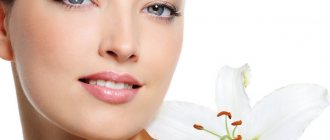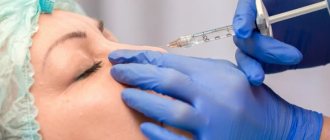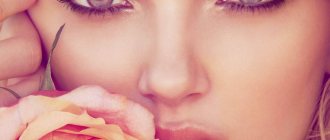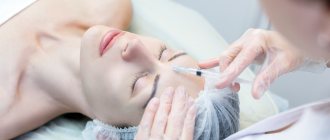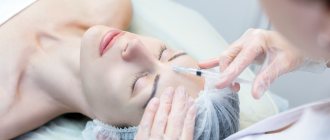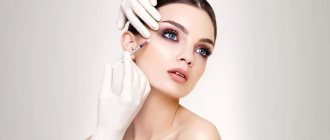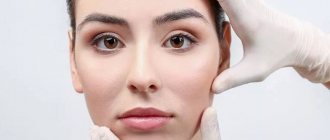How Botox works
Botox injection is an effective technique for eliminating facial wrinkles and forming a beautiful facial contour. Essentially, this is a correction without a scalpel.
Botox is a weakened, purified neurotoxic drug based on botulinum toxin. The latter is produced by the bacteria Clostridium botulinum. A powerful neuroparalytic that can relax facial muscles.
Botulinum toxin A has been used in cosmetology for more than 30 years. It is injected into the area of the facial muscle, as a result it relaxes, and the skin relief of the area is noticeably smoothed. The hydrobalance of the deep layers of the dermis is restored, the natural production of collagen and elastin is stimulated.
Botox is used to correct facial contours, smooth out wrinkles on the forehead, in the eye area and nasolabial triangle.
How to enlarge lips with Botox?
Let's start with the fact that the phrase “pump up your lips with Botox” is fundamentally wrong. If only because Botox is a drug that relaxes muscles, i.e. paralyzing them. Agree that knowing this, this phrase sounds funny. As a rule, Botox is used against wrinkles in the forehead, bridge of the nose, around the eyes, allows you to lift the eyebrows and smooth out the crease between the brows. Botox in the lip area is used to smooth out purse string wrinkles (vertical wrinkles above the lip), on the outer corners of the mouth and even to eliminate a gummy smile.
Exposure time
The duration of the effect of Botox depends on the individual characteristics of the body, habits, and care procedures:
- Age. Typically, botulinum therapy is indicated for people over 45 years of age, but often younger people also need correction. The breakdown of drug substances in a young body occurs faster, so the duration of the effect is reduced.
- Behavior. Poor nutrition, lack of sleep, stress and negative habits affect not only your well-being, but also your appearance - they worsen the effect of injections.
- Quality of the drug. The drug must be original and stored correctly.
Pro et Contra. Prevention of aging or fashion trend?
Several years ago, an article was published in a well-known fashion magazine in which young patients “in their early 20s” were encouraged to start taking botulinum toxin injections at such a young age.
The article at that time literally blew up the Internet and the medical community and, to some extent, contributed to the growing popularity of “beauty injections” among young patients. Now the topic raised in the article still remains relevant. And if fashion magazines unanimously shout that botulinum toxin can be used at any age and by everyone without exception, in the scientific community the attitude towards botulinum therapy is more restrained. We will discuss this topic again, and we will touch upon not only the medical validity of early correction, but also the moral and philosophical side of the issue.
Signs of Botox working
It is easy to feel the effect of botulinum toxin after the procedure: the facial muscles at the injection site stop working almost immediately, although a trace of the wrinkle will still be visible. For example, it will not be possible to frown your forehead, and, therefore, folds on the skin will not be able to form.
On days 5-7, the distribution of the drug ends, the effect becomes maximum: the skin is noticeably fresher, acquires a healthy shine and tint, and cosmetics fit perfectly on it. Even deep wrinkles are gradually smoothed out.
When administered correctly, Botox injections do not turn the face into a “mask.” There will still be facial expressions and emotions. To get truly excellent results, contact beauty centers - cosmetologists with extensive experience work there.
Forehead Botox - at what age? How to avoid expression lines
As for Botox, it's a different story. Often young 20-year-old girls have such active facial expressions that with the naked eye you can see how a wrinkle is laid and formed between the eyebrows or on the forehead. And it is clear that by the age of 30 she will definitely appear there.
In this case, I would start by using creams with peptides, which are good at blocking these muscles, but at the same time allow you to maintain “control of the situation.” If you inject Botox, then the girl will not record the moment when she wrinkles her forehead or moves her eyebrows: the muscles relax so much that it is simply impossible to do this. And if you use a cream with peptides, then every time she tries to frown, she will feel a clear obstacle.
If in two or three months these measures do not wean her from too active facial expressions, of course, you need to inject Botox. And it is likely that once will be enough: within six months the bad habit will disappear. And then all that remains is to simply maintain this result with the same drugs with peptides, so as not to forget about the problem and not to relax (that is, in this case, on the contrary, not to strain).
Some psychologists who are interested in cosmetology (as well as cosmetologists who are interested in psychotherapy) conduct such an experiment with patients who want to get rid of the manner of frowning and moving their eyebrows towards the bridge of their nose. They put sensors on their foreheads and show them a beautiful film about nature. As soon as the patient wants to express emotions by wrinkling her forehead, the sensor is triggered - and instead of beauty, a gray grid appears on the screen. Ten sessions give a 100% result.
That is, the habit of tense forehead muscles, like the habit of slouching, can be controlled without any Botox. But it takes time and a strong desire to get rid of it.
Yes, it is easier for some, more difficult for others. There are people who have only six attachment points for the frontalis muscle. There will be almost no wrinkles on their forehead even at 70 years old. And there are those who have 46 of these points - and who already at the age of 25 have an accordion on their forehead in seven rows. If such a person comes to a cosmetologist, yes, you need to inject Botox. And then there is the question of medical skill. If the doctor is good, he will do everything right.
Repeated procedures
After Botox is removed, you can repeat the course to get the results back. Wait until your facial muscles have fully recovered to get the best results.
If Botox was administered for the first time, a corrective session is usually carried out after 8 months. All subsequent injections are performed at intervals of 4-6 months. With this technique you can maintain consistently good results.
If procedures are performed too often, the sensitivity of the dermis and nerve structures increases significantly. Botox dissolves faster each time, correction is required more often.
How long does the effect of Botox last?
How effective Botox is is perhaps one of the most frequently asked questions. Here it should be understood that there simply cannot be an unambiguous answer to this question, since the duration of local muscle relaxation will, like the speed of achieving the effect, directly depend on the metabolic functions of the body, more simply, on the metabolic rate. However, experts say that after the first administration of the drug, the average duration of action of Botox will be from 4 to 6 months.
Also, speaking about the duration of action of Botox, it is simply impossible not to mention the increased effectiveness of the drug with repeated administration. Repeated injections show a significantly longer lasting effect, which can range from 8 to 12 months. In addition, regular use of botulinum therapy often gives the cosmetologist the opportunity to reduce the dosage. This is largely explained by the fact that being stationary for a long time, the facial muscle loses the “habit” of actively moving, and a person loses the habit of “frowning,” which reduces the load on the facial muscles and the severity of wrinkles.
Is it possible to extend the result?
Follow all the cosmetologist's recommendations to get the maximum, safe and prolonged effect of the procedure.
We will consider the main recommendations below:
- Physical activity in the first 7-10 days after the session significantly reduces the effect of botulinum therapy.
- There are no additional jokes between the main courses! They will provoke the production of antibodies, which destroy the toxin and reduce its effect to a minimum.
- Avoid solariums, baths and saunas.
- Assess the compatibility of current pharmacotherapy with contraindications to botulinum therapy.
Lifestyle after the procedure
The strictest recommendations for the first 3 days after the session:
- Avoid alcoholic drinks: ethyl alcohol increases blood flow to the face.
- Do not take hot baths or go to the sauna.
- Avoid visiting the beach and solarium.
- Protect your face from direct sunlight.
- Avoid even minimal physical activity.
- Do not take muscle relaxants, tetracycline antibiotics, or B vitamins.
- Do not massage the injection area.
Contraindications to Botox injection
Absolute:
- High myopia
- Hemophilia
- Lactation and pregnancy
- Acute infectious diseases
Relative:
- Tendency to facial swelling
- Aggravated allergic history (to protein-containing drugs)
- Severe hernias in the upper and lower eyelids
- Taking antibiotics aminoglycosides, tetracycline, polymyxins, which enhance the effect of the toxin
- Somatic diseases in the acute stage, alcohol abuse
Undesirable effects
It is impossible to predict in advance how the substance will be distributed, how muscle fibers will react to the effects of botulinum toxin.
Typical side effects are redness of the facial skin, the appearance of papules, pain, and swelling.
Rare complications and their causes:
- Strong relaxation of the frontal muscles gives the effect of lowered eyebrows.
- Excessive botulinum toxin injections can lead to eyelid spasm.
- Excessive physical activity and ignoring recommendations are a common cause of asymmetry, bruising, and articulation disorders.
- Individual reaction: headaches, lumps and papules at injection points, increased intraocular pressure.
What objective reasons can be considered indications for correction?
At a young age, patients most often resort to correction in order to delay the appearance of wrinkles (to minimize their appearance in older age) or to remove existing wrinkles.
With constant intense muscle contractions of the facial muscles, dynamic wrinkles can form even at a young age. Subsequently, atrophy of the skin and subcutaneous structures occurs, and static wrinkles are formed, which will become more and more pronounced with age.
In such a situation, the administration of small doses of neuroprotein blocks the release of acetylcholine into the neuromuscular junction and causes temporary chemical denervation of the overactive muscle, smoothes the skin and prevents its atrophy.
The first wrinkles most often appear in the upper third of the face (between the eyebrows, crow's feet, forehead). For some, they may appear after the age of 30, while others begin to notice them at 18.
There may be several reasons for the appearance of the first wrinkles at a young age:
- increased emotionality combined with active facial expressions (hyperkinetic type);
- fine-wrinkled type of aging;
- headache;
- voltage.
These reasons should be indications for early correction and the method of choice for young patients. After all, you can stop the hyperkinetic activity of muscles, which leads to the formation of dynamic wrinkles, only with botulinum therapy, and a pleasant addition will be the formation of the habit of correctly expressing emotions, because living without wrinkles is more fun than with them. Moreover, there is research that botulinum toxin can help patients cope with depression. According to scientists, paralysis of the muscles that are usually responsible for a dissatisfied, frowning appearance leads to a decrease in negative emotions. Consequently, a negative mood is more difficult to maintain, and thus the person experiences more positive emotions.


